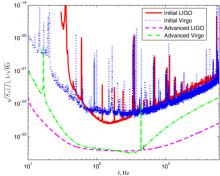
Abstract
We present an up-to-date, comprehensive summary of the rates for all types of compact binary coalescence sources detectable by the initial and advanced versions of the ground-based gravitational-wave detectors LIGO and Virgo. Astrophysical estimates for compact-binary coalescence rates depend on a number of assumptions and unknown model parameters and are still uncertain. The most confident among these estimates are the rate predictions for coalescing binary neutron stars which are based on extrapolations from observed binary pulsars in our galaxy. These yield a likely coalescence rate of 100 Myr−1 per Milky Way Equivalent Galaxy (MWEG), although the rate could plausibly range from 1 Myr−1 MWEG−1 to 1000 Myr−1 MWEG−1 (Kalogera et al2004 Astrophys. J. 601 L179; Kalogera et al 2004 Astrophys. J. 614 L137 (erratum)). We convert coalescence rates into detection rates based on data from the LIGO S5 and Virgo VSR2 science runs and projected sensitivities for our advanced detectors. Using the detector sensitivities derived from these data, we find a likely detection rate of 0.02 per year for Initial LIGO–Virgo interferometers, with a plausible range between 2 × 10−4 and 0.2 per year. The likely binary neutron–star detection rate for the Advanced LIGO–Virgo network increases to 40 events per year, with a range between 0.4 and 400 per year.